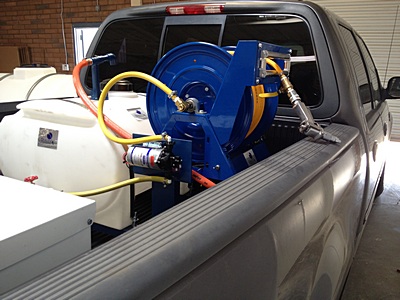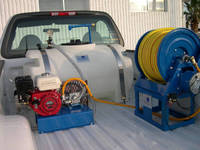Power Sprayers – Mounting Options
Posted by Andrew Greess on Nov 7, 2021
Power Spray Rigs
- Skid vs. Component vs. Trailer mount Power Sprayers
There are numerous ways to mount power spray equipment in a vehicle. The most common are skid, component and trailer mounts. Skid mount is attaching all the sprayer components on a metal (usually steel or aluminum) frame. The frame is then bolted to the vehicle. Component mount is bolting all the components individually to the vehicle. Trailer mount means mounting components on a trailer that’s towed behind the technician’s truck. Here are the pros and cons of each.
Pros
-Easy to install. Just bolt the skid to the vehicle.
-The skid provides numerous places to bolt the skid mount sprayer, which is helpful in compact pickup trucks where access under the bed is limited. Skid mount sprayers can also be mounted in ATVs.
-With only one unit, it’s easier to remove from the vehicle if vehicle is to be used for another purpose, replaced or down for service.
-Supports company equipment standardization because most equipment vendors build standard skid sprayers
Cons
-The frame adds cost and weight.
-Most companies don’t frequently move skids in and out of trucks, so the easy-to-move benefit isn’t that valuable.
-The equipment goes where the manufacturer puts it. Particularly on standard spray skids, the owner or operator of the equipment has no input on where the components are mounted. This can affect access for use and maintenance.
-Just because equipment fits in the current truck, doesn’t mean it will fit, or work well, when moved to a new truck.
Component (truck) mount power sprayers:
Pros
-Component mount sprayers save money and weight because there’s no skid to buy.
-Truck mount sprayers provide more flexibility when locating components where they’re convenient for operation and maintenance and to make room for other equipment, e.g., toolbox.
-Increases chances equipment will fit when moving it to a new truck.
-Strongly recommended for flatbed and large trucks to improve equipment access by moving equipment to the truck sides.
Cons
-Takes longer to install because all components (tank, pump, motor, reel) must be bolted down individually.
-Takes longer to move to a different vehicle because each component must be removed and reinstalled in new vehicle.
-Can be difficult to do in smaller vehicles. Gas tank, structural members and other components can make it difficult to bolt components in their desired locations.
Pros
-Flexibility. Sprayers in a truck have no flexibility. If the truck needs service or is in an accident, the sprayer is unavailable. A trailer mount sprayer can be used by multiple vehicles or technicians.
-Personal vehicle. For owner/operators, this is important. It took months to get reservations at the best restaurant in town. You put on your best duds and pick up your date. Do you want to arrive in a truck hauling a stinky pest control spray rig? If the sprayer is mounted in a trailer, you can leave it behind so you can strut your stuff.
-Space. Spray Trailers often can hold larger water tanks than a pickup truck. This enables performance of more or larger jobs. The trailer dramatically increases the size and volume of equipment you can carry with you on your route.
-Backup. A trailer mount makes a great backup when another sprayer is down.
-Equipment location. There’s more flexibility in equipment location in a trailer. In a pickup truck, numerous constraints (gas tank, wheel wells, structural members under the bed) can make it difficult to place equipment exactly where you want it.
Cons
- Safety. Hauling a 3,000-pound spray trailer behind you in traffic causes safety concerns. Stopping distances increase. Ability to maneuver to avoid traffic is reduced. Safety is less of a concern when the company owner is driving compared to a 21-year-old employee who’s driving and texting his girlfriend.
- Maneuverability. It’s more difficult to maneuver – parking, backing up and turning around in tight spaces – a vehicle with a spray trailer behind it.
- Cost. The trailer is an additional cost compared to putting the sprayer in a truck.
- Storage. Finding additional space to store the trailer can be problematic.
- Theft. Trailers are targets for thieves. Plenty of trailers are stolen, even when chained to a lamppost.
Important Notes for Trailer Mount Sprayers:
Install equipment on the trailer so the trailer is slightly tongue heavy, which usually means placing the water tank over, then slightly forward, of the axle.
Contact your insurance agent before buying a trailer to identify insurance related issues.




